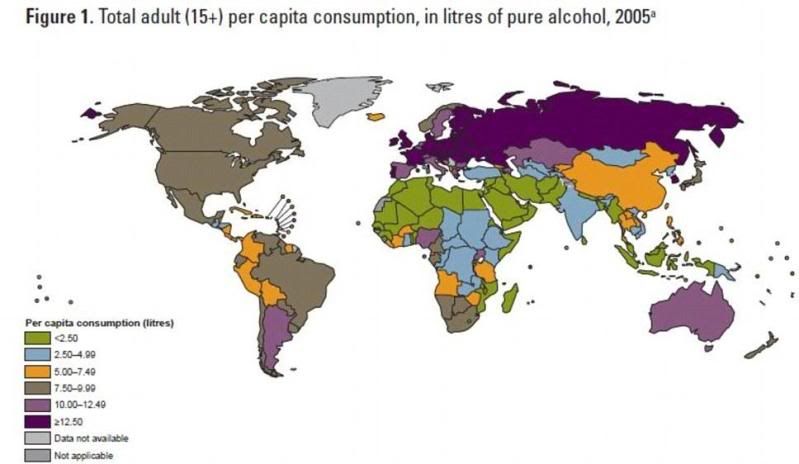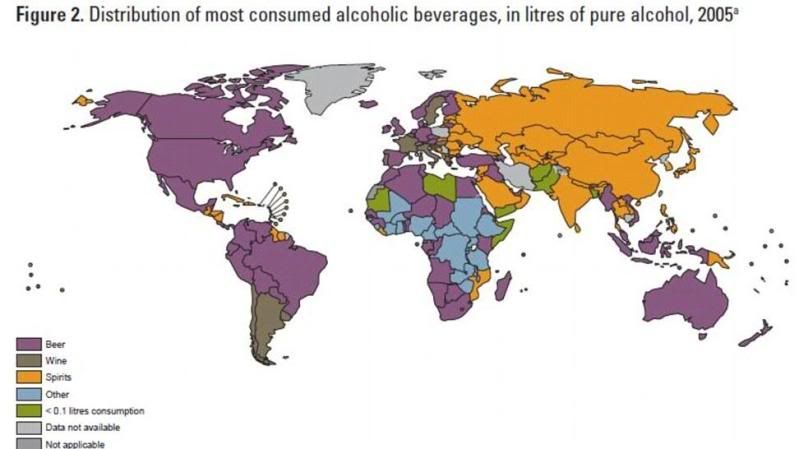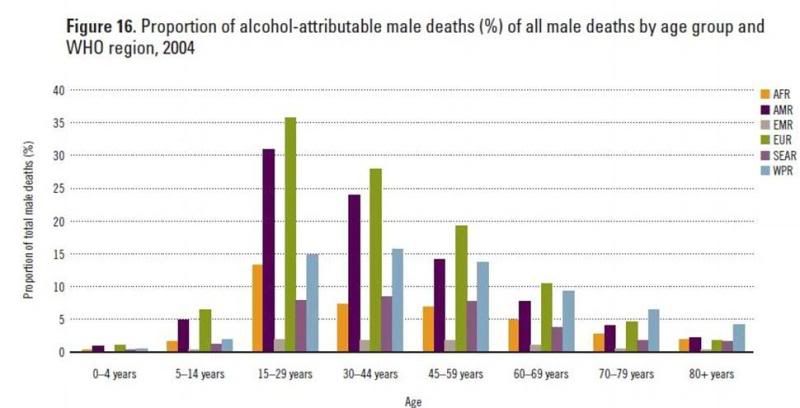The U.S. has one of the lowest rates of drinking in the developed world, new figures have revealed.
Average Americans drank just 9.4 litres of alcohol a year - the same as 470 pints of mild beer or 31 glasses of wine.
The figure is much lower than Europe where the average British drinker sinks 1100 pints of beer each year and Russians have 1350 pints of beer and 90 bottles of vodka.

Maps released by the World Health Authority show that the average American drinks between seven and a half and 10 litres of pure alcohol each year.
The preferred drink in the U.S. is beer, accounting for 53 per cent of alcohol consumption, whereas in France the favourite drink is wine and in Russia it is vodka.
Spirits make up 31 per cent of alcohol consumption in the US and wine accounts for just 16 per cent.
But the region also has one of the highest rates of alcohol related deaths coming second only behind Europe. In America 31 per cent of all deaths of 15 to 29-year-olds were alcohol related.
The U.S. also has one of the highest rates of people who abstain from drinking with 35 per cent of residents preferring not to drink.
The average drinker in the UK has 15-and-a-half litres of pure alcohol a year - the equivalent of 775 pints of beer. That's the same as 516 glasses of strong wine or 1000 shots of whiskey or other spirits. Only east European countries such as Russia, have higher rates of drinking than the UK.
In Russia the average drinker consumes a staggering 27 litres of pure alcohol a year and in Moldova 23 litres a year. On average Russians drink 1350 pints of beer a year or 90 bottles of Vodka.


In France the majority of adults drink wine, taking their average consumption to 1490 units a year.That is roughly 500 glasses of wine.
Areas of the map that are coloured green show strict Muslim countries such as Iran, Iraq and Afghanistan where drinking is banned. There alcohol consumption is less than 250 units a year - or just over 125 pints of beer.
The research was carried out by the World Health Organisation (WHO) which measured alcohol consumption between 2000 and 2005.
Dr Ala Alwan, WHO Assistant Director-General for Non-communicable Diseases and Mental Health said: 'Many countries recognize the serious public health problems caused by the harmful use of alcohol and have taken steps to prevent the health and social burdens and treat those in need of care.
'But clearly much more needs to be done to reduce the loss of life and suffering associated with harmful alcohol use.'
In the US, male drinkers drank twice as much as females. Regular male drinkers consumed 2000 units of alcohol compared with just 850 for women. In Britain, men also drank around twice as much as women during the same period.
The average consumption for males was 22 litres of pure alcohol a year compared with just nine and a half litres for women.
But when the figures included people who did not drink the average person drank just 13.4 litres of alcohol a year which is 1340 units of alcohol or 670 pints of beer.
The figures show that the average male drinker in the US drank 1000 pints of beer or 222 bottles of wine throughout the year. But women drank just 42 pints of beer or 280 glasses of wine.
One litre of pure alcohol contains 1000 millilitres. There are 10 millilitres in every unit of alcohol.
The research also revealed which drinks people each country prefer. Drinkers in Britain and the U.S. mainly drank beer, in France it was wine and in Russia it was spirits
The research also found that the highest number of alcohol related deaths occurred in Europe and America in those aged between 15 and 29. Worryingly, in Europe just over 35 per cent of deaths in that age groups were attributed to alcohol.
Countries where people drank the least included parts of the developing world such as Africa and Asia. But these countries also showed the biggest increase in drinking in line with rapid economic development.
The average worldwide consumption in 2005 was equal to 6.13 litres of pure alcohol per person aged 15 years or older, according to the report.
A World Health Organisation spokesman said: 'Analysis from 2001-2005 showed countries in the WHO Americas, European, Eastern Mediterranean and Western Pacific regions had relatively stable consumption levels during that time; but marked increases were seen in Africa and South-East Asia during the five-year period.
'Despite widespread consumption, most people do not drink. Almost half of all men and two-thirds of women did not consume alcohol in 2005, according to the latest information made available in the report.
'Abstention rates are low in high-income, high consumption countries, and higher in North African and South Asian countries. But those who do drink in countries with high abstention rates consume alcohol at high levels.
'Too few countries use effective policy options to prevent death, disease and injury from alcohol use.
' From 1999, when WHO first began to report on alcohol policies, at least 34 countries have adopted some type of formal policies to reduce harmful use of alcohol.
' Restrictions on alcohol marketing and on drink–driving have increased, but there are no clear trends on most preventive measures. Many countries have weak alcohol policies and prevention programmes. '
Average Americans drank just 9.4 litres of alcohol a year - the same as 470 pints of mild beer or 31 glasses of wine.
The figure is much lower than Europe where the average British drinker sinks 1100 pints of beer each year and Russians have 1350 pints of beer and 90 bottles of vodka.

Maps released by the World Health Authority show that the average American drinks between seven and a half and 10 litres of pure alcohol each year.
The preferred drink in the U.S. is beer, accounting for 53 per cent of alcohol consumption, whereas in France the favourite drink is wine and in Russia it is vodka.
Spirits make up 31 per cent of alcohol consumption in the US and wine accounts for just 16 per cent.
But the region also has one of the highest rates of alcohol related deaths coming second only behind Europe. In America 31 per cent of all deaths of 15 to 29-year-olds were alcohol related.
The U.S. also has one of the highest rates of people who abstain from drinking with 35 per cent of residents preferring not to drink.
The average drinker in the UK has 15-and-a-half litres of pure alcohol a year - the equivalent of 775 pints of beer. That's the same as 516 glasses of strong wine or 1000 shots of whiskey or other spirits. Only east European countries such as Russia, have higher rates of drinking than the UK.
In Russia the average drinker consumes a staggering 27 litres of pure alcohol a year and in Moldova 23 litres a year. On average Russians drink 1350 pints of beer a year or 90 bottles of Vodka.


In France the majority of adults drink wine, taking their average consumption to 1490 units a year.That is roughly 500 glasses of wine.
Areas of the map that are coloured green show strict Muslim countries such as Iran, Iraq and Afghanistan where drinking is banned. There alcohol consumption is less than 250 units a year - or just over 125 pints of beer.
The research was carried out by the World Health Organisation (WHO) which measured alcohol consumption between 2000 and 2005.
Dr Ala Alwan, WHO Assistant Director-General for Non-communicable Diseases and Mental Health said: 'Many countries recognize the serious public health problems caused by the harmful use of alcohol and have taken steps to prevent the health and social burdens and treat those in need of care.
'But clearly much more needs to be done to reduce the loss of life and suffering associated with harmful alcohol use.'
In the US, male drinkers drank twice as much as females. Regular male drinkers consumed 2000 units of alcohol compared with just 850 for women. In Britain, men also drank around twice as much as women during the same period.
The average consumption for males was 22 litres of pure alcohol a year compared with just nine and a half litres for women.
But when the figures included people who did not drink the average person drank just 13.4 litres of alcohol a year which is 1340 units of alcohol or 670 pints of beer.
The figures show that the average male drinker in the US drank 1000 pints of beer or 222 bottles of wine throughout the year. But women drank just 42 pints of beer or 280 glasses of wine.
One litre of pure alcohol contains 1000 millilitres. There are 10 millilitres in every unit of alcohol.
The research also revealed which drinks people each country prefer. Drinkers in Britain and the U.S. mainly drank beer, in France it was wine and in Russia it was spirits
The research also found that the highest number of alcohol related deaths occurred in Europe and America in those aged between 15 and 29. Worryingly, in Europe just over 35 per cent of deaths in that age groups were attributed to alcohol.
Countries where people drank the least included parts of the developing world such as Africa and Asia. But these countries also showed the biggest increase in drinking in line with rapid economic development.
The average worldwide consumption in 2005 was equal to 6.13 litres of pure alcohol per person aged 15 years or older, according to the report.
A World Health Organisation spokesman said: 'Analysis from 2001-2005 showed countries in the WHO Americas, European, Eastern Mediterranean and Western Pacific regions had relatively stable consumption levels during that time; but marked increases were seen in Africa and South-East Asia during the five-year period.
'Despite widespread consumption, most people do not drink. Almost half of all men and two-thirds of women did not consume alcohol in 2005, according to the latest information made available in the report.
'Abstention rates are low in high-income, high consumption countries, and higher in North African and South Asian countries. But those who do drink in countries with high abstention rates consume alcohol at high levels.
'Too few countries use effective policy options to prevent death, disease and injury from alcohol use.
' From 1999, when WHO first began to report on alcohol policies, at least 34 countries have adopted some type of formal policies to reduce harmful use of alcohol.
' Restrictions on alcohol marketing and on drink–driving have increased, but there are no clear trends on most preventive measures. Many countries have weak alcohol policies and prevention programmes. '


